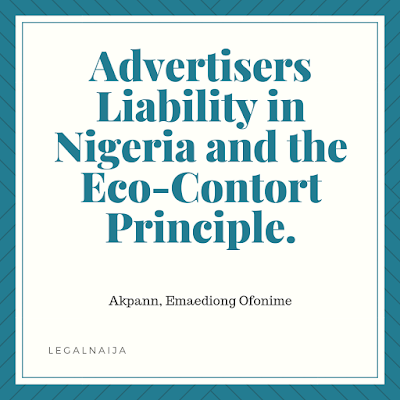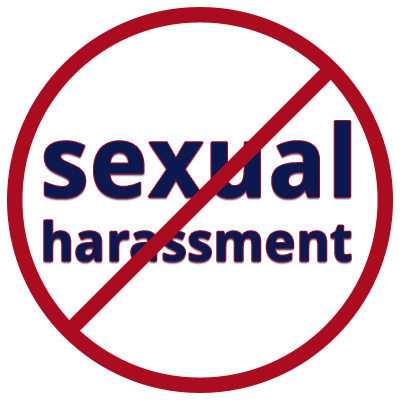
Advertisers Liability in Nigeria and the Eco-Contort Principle | Akpan, Emaediong Ofonime

1.0 Introduction
The first victim of advertisement suffered the lack of redress solely
because the liability regime in existence was heavily laden with the caveat ‘buyer beware.’ This caveat reads
thus; ‘….but the fruit of the tree which is in the midst of the garden…….God
has said you shall not eat it, neither shall you touch it …’ [ii] This caveat may be said to have
allowed the advertiser act with reckless abandon, transferring in whole, the
liability of his actions on the consumer’s inability to adhere to warnings. It
leaves out the question of the consumer’s ability to understand such warning
and re-enforces the advertiser as king who has usurped the powers of the
consumer.
because the liability regime in existence was heavily laden with the caveat ‘buyer beware.’ This caveat reads
thus; ‘….but the fruit of the tree which is in the midst of the garden…….God
has said you shall not eat it, neither shall you touch it …’ [ii] This caveat may be said to have
allowed the advertiser act with reckless abandon, transferring in whole, the
liability of his actions on the consumer’s inability to adhere to warnings. It
leaves out the question of the consumer’s ability to understand such warning
and re-enforces the advertiser as king who has usurped the powers of the
consumer.
Another bone of contention has been largely predicated on the nature of
relationship between the advertiser and the consumer who has been injured. It
must be mentioned at this point that the business relationship that resulted in
Eve being harmed was without any consideration or contractual relations, and
centuries after such liability regime has continued to work hardship for
consumers especially the vulnerable. The liability of an advertiser has been
the also been the bone of contention from time immemorial. It is evident in the
brief argument that ensued between Adam and Eve on the one part, and God on the
other after they had consumed the product advertised to them. While Adam placed
the liability on Eve (the retailer or distributor); Eve if probably asked would
have placed the liability on the Serpent (the advertiser) and the Serpent would
have placed the liability on God (the producer).[iii] This argument is vital because it determines, the duty of care, the
demarcating lines for proving negligence and the right to claim redress.
relationship between the advertiser and the consumer who has been injured. It
must be mentioned at this point that the business relationship that resulted in
Eve being harmed was without any consideration or contractual relations, and
centuries after such liability regime has continued to work hardship for
consumers especially the vulnerable. The liability of an advertiser has been
the also been the bone of contention from time immemorial. It is evident in the
brief argument that ensued between Adam and Eve on the one part, and God on the
other after they had consumed the product advertised to them. While Adam placed
the liability on Eve (the retailer or distributor); Eve if probably asked would
have placed the liability on the Serpent (the advertiser) and the Serpent would
have placed the liability on God (the producer).[iii] This argument is vital because it determines, the duty of care, the
demarcating lines for proving negligence and the right to claim redress.
Nigeria is yet to have an articulated body of laws termed ‘Advertiser’s
Liability Law’ or an aspect of its advertising law that deals solely on the
liability of the advertiser.[iv] For the protection of consumers, there is a reliance on the rules of
liability under the laws of contract, tort and also under criminal powers of
some regulatory frameworks. Most of the parameters for situating liability have
been developed extensively on goods as opposed to services.[v]
Liability Law’ or an aspect of its advertising law that deals solely on the
liability of the advertiser.[iv] For the protection of consumers, there is a reliance on the rules of
liability under the laws of contract, tort and also under criminal powers of
some regulatory frameworks. Most of the parameters for situating liability have
been developed extensively on goods as opposed to services.[v]
2.0 The Liability Regime in
Nigeria
Nigeria
The liability for defective products is borne by the producer or such a
person that holds out himself as a producer. These include persons who mark or
name appears on the product, the importer or distributor and so forth.[vi]
This implies that the manufacturer of products and sometimes the person in the
distribution chain owe a duty of care to the consumer of that product. This
position was enunciated in Donoghue v
Stevenson[vii]
where the House of Lords held that the defendants who were manufacturers of
drinks, owed a duty of care to the plaintiff, who became sick after drinking a
bottle of the manufacturer‘s ginger beer, bought for her by a friend at a
restaurant and which contained the decomposed remains of a snail.
person that holds out himself as a producer. These include persons who mark or
name appears on the product, the importer or distributor and so forth.[vi]
This implies that the manufacturer of products and sometimes the person in the
distribution chain owe a duty of care to the consumer of that product. This
position was enunciated in Donoghue v
Stevenson[vii]
where the House of Lords held that the defendants who were manufacturers of
drinks, owed a duty of care to the plaintiff, who became sick after drinking a
bottle of the manufacturer‘s ginger beer, bought for her by a friend at a
restaurant and which contained the decomposed remains of a snail.
Product liability[viii]
is a tort which imposes liability on manufacturers and sellers of products that
are manufactured or sold in defective condition. A product is defective if it
is unreasonably dangerous to the user. Liability is tied to physical or
emotional injury to the ultimate consumer as was held in Constance Ngonadi vs Nigerian Bottling Co. Ltd.[ix]
The consumer is saddled with proving that a manufacturer was negligent.[x]
The privity of contract has created a lot of hardship for the assignment of
liability in the case of advertisements. However it is workable for goods since
it is hinged on consideration;[xi]
hence it defines the scope for persons who can hold the producer liable for
defective goods.[xii]
The loopholes in the privity of contract were addressed by the exceptions of
negligence and duty of care. The current test for a duty of care can be found
in the judgment of Caparo Industries Plc
vs Dickman.[xiii]
Lord Oliver‘s speech in the above case sets the test for a duty of care thus;
is a tort which imposes liability on manufacturers and sellers of products that
are manufactured or sold in defective condition. A product is defective if it
is unreasonably dangerous to the user. Liability is tied to physical or
emotional injury to the ultimate consumer as was held in Constance Ngonadi vs Nigerian Bottling Co. Ltd.[ix]
The consumer is saddled with proving that a manufacturer was negligent.[x]
The privity of contract has created a lot of hardship for the assignment of
liability in the case of advertisements. However it is workable for goods since
it is hinged on consideration;[xi]
hence it defines the scope for persons who can hold the producer liable for
defective goods.[xii]
The loopholes in the privity of contract were addressed by the exceptions of
negligence and duty of care. The current test for a duty of care can be found
in the judgment of Caparo Industries Plc
vs Dickman.[xiii]
Lord Oliver‘s speech in the above case sets the test for a duty of care thus;
(a) The harm which occurred must be a reasonable foreseeable result of
the defendant‘s conduct;
the defendant‘s conduct;
(b) A sufficient relationship of proximity or neighbourhood exists
between the alleged wrongdoer and the person who has suffered damage;
between the alleged wrongdoer and the person who has suffered damage;
(c) It is fair, just and reasonable to impose liability.
3.0 The Monstrosities in
Evolving a Service Liability Regime for Advertisers
Evolving a Service Liability Regime for Advertisers
While the last limb of the test on reasonable and just need to impose
liability may be appropriately applied to the advertising sector it may be
difficult or almost impossible to establish the existence of a sufficient
relationship of proximity and neighbourhood since advertisements are simply an
invitation to treat and not in itself sufficient to import a contractual
relationship. It is also difficult to place the advertiser or manufacturer
within a water tight compartment to establish mens rea. This is because the manufacturer in defence may state
that such advertisements were outsourced to an advertising agency who was
supposed to act as a professional. Conversely the advertiser may state that the
advertisements were subject to final verification by the manufacturer hence
they acted solely on his instructions as an employee as opposed to a contract
for service. While jurisdictions like China place liability on the advertisers
giving them the responsibility of verifying the contents and claims of
advertisements which they put out or consumers. In the light of the foregoing
it has become necessary to examine the Eco-Contort Principle as a possible
liability principle for advertisements with a few modifications.[xiv]
The eco-contort principle is a combination of economic or business
consideration, privity of contract and the neighbourhood principle within the
precinct of tortious liability. This presupposes an amalgamation of other
liability regime to ensure that consumer redress is not sacrificed on the altar
of a tight compartment of strict rules. However, the eco-contort liability
principle still makes consideration a paramount factor thereby almost leaving
the consumer who has not acted upon the advertisement to mature into a
contractual relation without a basis for his claims. This will continue to
allow the advertiser the leeway to continue with reckless abandon the
exploitation of the vulnerable consumer.
liability may be appropriately applied to the advertising sector it may be
difficult or almost impossible to establish the existence of a sufficient
relationship of proximity and neighbourhood since advertisements are simply an
invitation to treat and not in itself sufficient to import a contractual
relationship. It is also difficult to place the advertiser or manufacturer
within a water tight compartment to establish mens rea. This is because the manufacturer in defence may state
that such advertisements were outsourced to an advertising agency who was
supposed to act as a professional. Conversely the advertiser may state that the
advertisements were subject to final verification by the manufacturer hence
they acted solely on his instructions as an employee as opposed to a contract
for service. While jurisdictions like China place liability on the advertisers
giving them the responsibility of verifying the contents and claims of
advertisements which they put out or consumers. In the light of the foregoing
it has become necessary to examine the Eco-Contort Principle as a possible
liability principle for advertisements with a few modifications.[xiv]
The eco-contort principle is a combination of economic or business
consideration, privity of contract and the neighbourhood principle within the
precinct of tortious liability. This presupposes an amalgamation of other
liability regime to ensure that consumer redress is not sacrificed on the altar
of a tight compartment of strict rules. However, the eco-contort liability
principle still makes consideration a paramount factor thereby almost leaving
the consumer who has not acted upon the advertisement to mature into a
contractual relation without a basis for his claims. This will continue to
allow the advertiser the leeway to continue with reckless abandon the
exploitation of the vulnerable consumer.
In Tamara Egbedi v. (Our Daily
Manna ) The Registered Trustees of the Chapel of Liberty[xv]
the plaintiff, Ms Egebedi a lawyer
approached the court to enforce the payment of damages she incurred in acting
on an advertisement for a religious crusade by the defendants popularly known
as Our Daily Manna which she attended
and sustained injuries. Candide Johnson in delivering the judgement stated that
the defendants put themselves forward as spiritual shepherds and hence owed a
duty of care to the public whom they had invited through advertisements to
their spiritual crusade. If this be the case that a plaintiff who offered no
consideration towards an advertisement then it follws that the vulnerable
consumer who only views an advertisement can also bring a claim against the
proprietors of such advertisement. This is favourable to the vulnerable
consumer as it will no longer allow the advertiser avoid liability on the basis
of a non-existent contractual relationship.
Manna ) The Registered Trustees of the Chapel of Liberty[xv]
the plaintiff, Ms Egebedi a lawyer
approached the court to enforce the payment of damages she incurred in acting
on an advertisement for a religious crusade by the defendants popularly known
as Our Daily Manna which she attended
and sustained injuries. Candide Johnson in delivering the judgement stated that
the defendants put themselves forward as spiritual shepherds and hence owed a
duty of care to the public whom they had invited through advertisements to
their spiritual crusade. If this be the case that a plaintiff who offered no
consideration towards an advertisement then it follws that the vulnerable
consumer who only views an advertisement can also bring a claim against the
proprietors of such advertisement. This is favourable to the vulnerable
consumer as it will no longer allow the advertiser avoid liability on the basis
of a non-existent contractual relationship.
4.0 Conclusion/Recommendation
If the eco-contort
liability principle is expanded to accommodate the court’s decision in Tamara Egbedi v. (Our Daily Manna ) The
Registered Trustees of the Chapel of Liberty[xvi]
it will offer some amount of protection to the vulnerable consumer who has not
furnished any consideration towards the maturity of any advertisements
into a contractual relationship but is
nevertheless affected by the mere viewing of such advertisements. It may also
open a floodgate of law suits thereby stifling economic activities but it will
offer vulnerable consumers the much needed protection and afford regulatory
agencies the necessary parameters for achieving a balance.
liability principle is expanded to accommodate the court’s decision in Tamara Egbedi v. (Our Daily Manna ) The
Registered Trustees of the Chapel of Liberty[xvi]
it will offer some amount of protection to the vulnerable consumer who has not
furnished any consideration towards the maturity of any advertisements
into a contractual relationship but is
nevertheless affected by the mere viewing of such advertisements. It may also
open a floodgate of law suits thereby stifling economic activities but it will
offer vulnerable consumers the much needed protection and afford regulatory
agencies the necessary parameters for achieving a balance.
END NOTES
[i] Akpan, Emaediong Ofonime is
currently undergoing postgraduate studies at the University of Uyo and majors
in Consumer Protection. She can be reached at akpanemaediongofonime@gmail.com.
currently undergoing postgraduate studies at the University of Uyo and majors
in Consumer Protection. She can be reached at akpanemaediongofonime@gmail.com.
[ii] King James, Easy Reading Version :The Holy
Bible , Genesis Chapter 3: 1 King James Version G.E.M Publishing, 2001 p. 2-5. Eve the first woman according
to Christian theological history was made out of man and both lived in the
Garden of Eden.
Bible , Genesis Chapter 3: 1 King James Version G.E.M Publishing, 2001 p. 2-5. Eve the first woman according
to Christian theological history was made out of man and both lived in the
Garden of Eden.
[iv] A model example is Advertising Law of
the People’s Republic of China 2015
the People’s Republic of China 2015
[v] E Ekanem ‘No Longer at Ease: The
Contract-Based Liability Posture of the Nigerian Law Toward Consumers of
Hospitality Services’ (2015) Journal of
Humanities and Social Science. Pp.10-19.
Contract-Based Liability Posture of the Nigerian Law Toward Consumers of
Hospitality Services’ (2015) Journal of
Humanities and Social Science. Pp.10-19.
[vi] Malemi, E., Law of Tort,
Princetown Publishing Company, Lagos, 1st ed. p. 267
Princetown Publishing Company, Lagos, 1st ed. p. 267
[vii] (1932) AC. 562 at 599
[viii] The tort protects the consumer
from unfair trade practices by manufacturers and other key players in the chain
of distribution who put in the market potentially dangerous and shoddy consumer
products, unwholesome and adulterated food, fake and substandard food and fake
drugs.
from unfair trade practices by manufacturers and other key players in the chain
of distribution who put in the market potentially dangerous and shoddy consumer
products, unwholesome and adulterated food, fake and substandard food and fake
drugs.
[ix] (1985) 1 NWLR pt.4 p.739 – where
the Plaintiff/Appellant sustained severe injuries from a brand of Kerosene
refrigerator, which was sold to her by the defendant/Respondent.
the Plaintiff/Appellant sustained severe injuries from a brand of Kerosene
refrigerator, which was sold to her by the defendant/Respondent.
[x] I Omadane Edegbo ‘An Assessment Of
Consumer Rights In Nigeria: A Case Study of The Sachet Water Industry’
Masters’ Dissertation Ahmadu Bello
University,
Consumer Rights In Nigeria: A Case Study of The Sachet Water Industry’
Masters’ Dissertation Ahmadu Bello
University,
[xi] Dunlop Pneumatic Tyre Co. Ltd vs
Selfridge Ltd. (1915) AC 487 at 853
Selfridge Ltd. (1915) AC 487 at 853
[xii] Sagay, I., (2000).Nigerian Law of
Contract, Spectrum Law Series, Ibadan p. 489
Contract, Spectrum Law Series, Ibadan p. 489
[xiii] (1990) 2 AC 605
[xiv] E E Ekanem ‘No Longer at Ease:
The Contract-Based Liability Posture of
the Nigerian Law Towards Consumers of Hospitality Services ’ (2015) Journal of Humanities and Social Sciences
20(9)pp10-19. Retrieved from www.iosjournals.org.Aceessed
1/1/2018.
The Contract-Based Liability Posture of
the Nigerian Law Towards Consumers of Hospitality Services ’ (2015) Journal of Humanities and Social Sciences
20(9)pp10-19. Retrieved from www.iosjournals.org.Aceessed
1/1/2018.
[xv] Suit no: LD/359/2011. Retrieved
from www.thenigerialawyer.com
Accessed 1/6/2018.
from www.thenigerialawyer.com
Accessed 1/6/2018.
[xvi] Suit no: LD/359/2011. Retrieved from
www.thenigerialawyer.com
Accessed 1/6/2018.
www.thenigerialawyer.com
Accessed 1/6/2018.

Akpan, Emaediong Ofonime
Emaediong Akpan is a postgraduate student passionate
about consumer protection. Her interests also spans grey areas of Law including
but not limited to IVF and cybercrime
about consumer protection. Her interests also spans grey areas of Law including
but not limited to IVF and cybercrime


